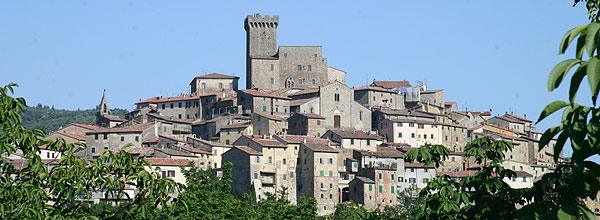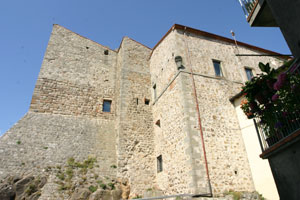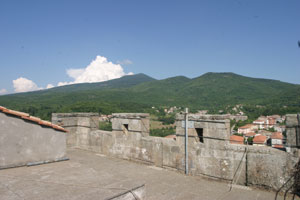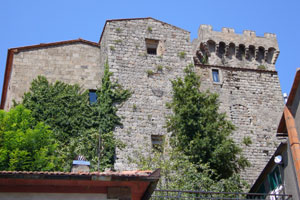Rocca Aldobrandesca
Arcidosso
 |
Arcidosso rises at 679 meters above sea level on the western slopes of Monte Amiata.
»
More Photos
» Where is the Rocca Aldobrandesca
di Arcidosso located ?
 The
first certain documentation of the existance of the settlement of Arcidosso
is from the year 860 where it is said to belong to the Abbey of San Salvatore.
The construction of the first nucleus of the castle, around which the
town will develop, is from about the year 1000. From the 12th to the 14th
century it was a stronghold of the Aldobrandeschi counts and became an
important military fortress, bulwark against invasion by Siena in the
Amiata territory.
The
first certain documentation of the existance of the settlement of Arcidosso
is from the year 860 where it is said to belong to the Abbey of San Salvatore.
The construction of the first nucleus of the castle, around which the
town will develop, is from about the year 1000. From the 12th to the 14th
century it was a stronghold of the Aldobrandeschi counts and became an
important military fortress, bulwark against invasion by Siena in the
Amiata territory.
 In
1331, Guidoriccio da Fogliano, seiged it for four months using an army
of 4000 soldiers and 400 horsemen, achieving its surrender. After the
fall of the Senese Republic, in 1556 it passed under the Medici rule.
Cosimo I established many outlying offices here, making it become an important
center. Following the Reformation Leopoldina of 1786, the redistributed
the state and ecclesiastic lands, Arcidosso passed under the rule of the
Lorena. This generated a conspicuous demographic increment and the number
of its citizens quadrupled in about 100 years. Arcidosso therefore became
historically the most important political and administrative center of
Monte Amiata.
In
1331, Guidoriccio da Fogliano, seiged it for four months using an army
of 4000 soldiers and 400 horsemen, achieving its surrender. After the
fall of the Senese Republic, in 1556 it passed under the Medici rule.
Cosimo I established many outlying offices here, making it become an important
center. Following the Reformation Leopoldina of 1786, the redistributed
the state and ecclesiastic lands, Arcidosso passed under the rule of the
Lorena. This generated a conspicuous demographic increment and the number
of its citizens quadrupled in about 100 years. Arcidosso therefore became
historically the most important political and administrative center of
Monte Amiata.
 The
historic center of Arcidosso, one of the most striking of Amiata, develops
in a long pyramid shape along the plateau dominated by the Aldobrandesca
Fortress. The actual aspect of the fortress is the result of various extensions
added to the original Longobard constructio(n from the 11th century, and
is made up of an imposing building divide in two parts (one lower than
the other), with a square section that rests upon, along a large part
of the perimeter, a large foundation, the exterior walls are covered in
"filaretto".
The
historic center of Arcidosso, one of the most striking of Amiata, develops
in a long pyramid shape along the plateau dominated by the Aldobrandesca
Fortress. The actual aspect of the fortress is the result of various extensions
added to the original Longobard constructio(n from the 11th century, and
is made up of an imposing building divide in two parts (one lower than
the other), with a square section that rests upon, along a large part
of the perimeter, a large foundation, the exterior walls are covered in
"filaretto".
 The
north side of the complex is characterized by the presence of a tower
that rises beyond the roof of the highest building in the compound. The
top of the tower is crowned by a series of blind arches resting on shelves,
the make up the base of the battlements below. The fortress, recently
restored, is used today as a space for cultural activities. From the top
of the tower there is a splendid panorama of Mount Amiata.
The
north side of the complex is characterized by the presence of a tower
that rises beyond the roof of the highest building in the compound. The
top of the tower is crowned by a series of blind arches resting on shelves,
the make up the base of the battlements below. The fortress, recently
restored, is used today as a space for cultural activities. From the top
of the tower there is a splendid panorama of Mount Amiata.
Only three gates of the original medieval walls remain, of which two are original – the Porta di Castello and the Porta Talassese towards the sea. From here, going down towards Codaccio, one finds the Porta dell’Orologio, built in 1851 to replace the Porta di Mezzo.
| More Photos |
| Back to Homepage |
| Back to Castles Index |